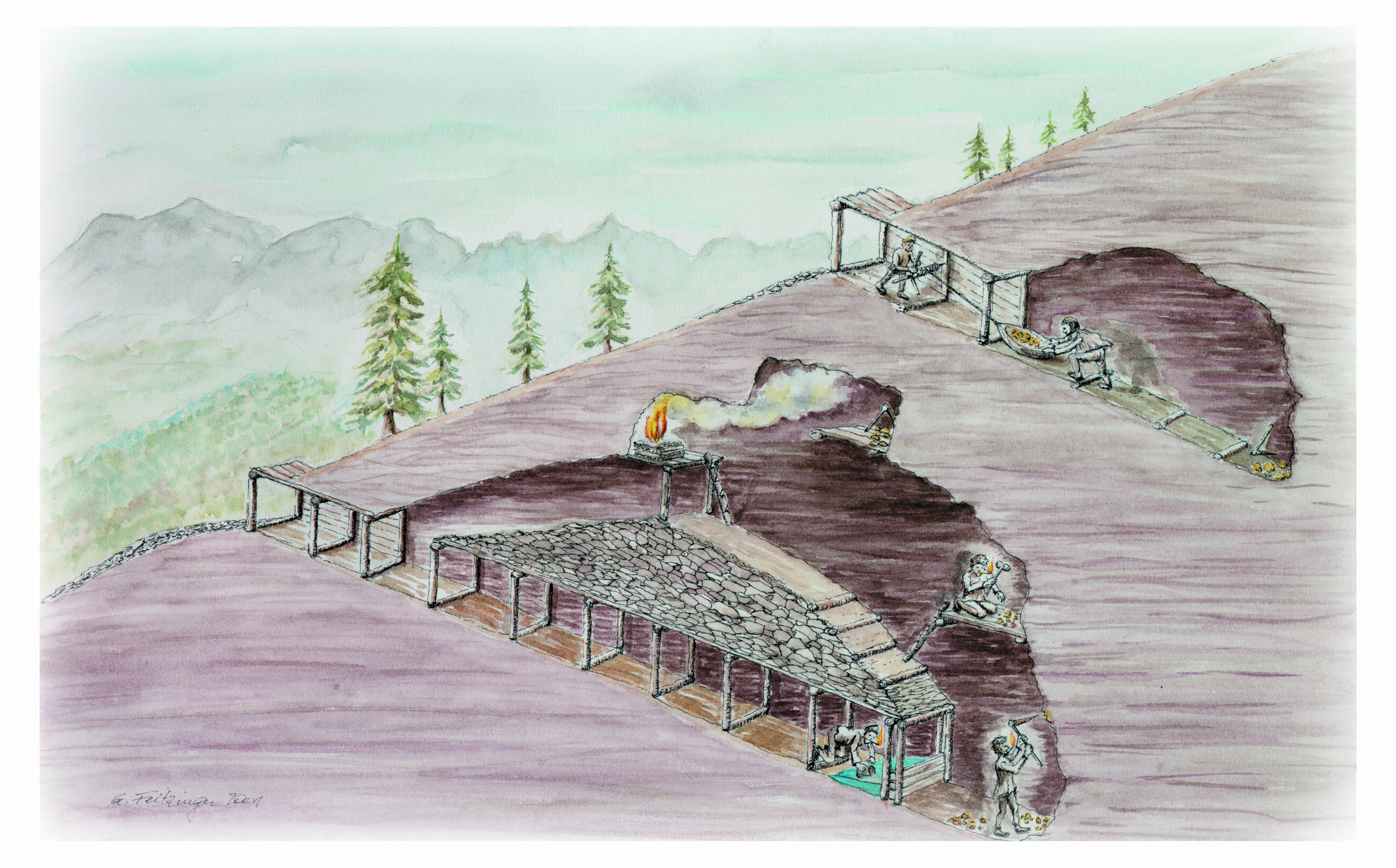The Celtic Hole
The "Celtic Hole“ provides a window into
the prehistoric mining era (approximately
1,000 to 1,800 years before Christ). When
modern copper mining began at Mitterberg
(Mühlbach am Hochkönig) in 1829, the
"Mariahilfstollen“ was initiated. Not far
from the entrance, a prehistoric mining
tunnel was discovered, leading to the
"Keltenloch.“
Until a few years ago, it was possible
to descend about 10 meters into
the Keltenloch and explore inside.
Unfortunately, due to the risk of collapse
in the entrance area, it is no longer safe to
enter. To get an idea, please refer to the
photo with the "Kelten."
Kids
Ores
Very few metals occur in the earth in pure form. Precious metals such as gold and silver are particularly rare. Most metals are usually chemically combined with oxygen or sulphur. Metallic minerals are called ores. Even thousands of years ago, people mastered the art of finding ores and extracting metals from them. Ores are usually only found in small quantities and are mixed with barren (non-ore-bearing) rock. In some places they have become enriched, making mining worthwhile. The origin of ores is still not fully understood.
Many ores with silver, copper, lead and zinc compounds can form when, as a result of movements in the earth's crust, hot mineral-rich water rises from the earth's interior in the fissures of "torn" mountains. Ore-bearing minerals grow in these fissures. Where the ore content is particularly rich, it can be extracted in an ore mine.
During the weathering of gold-bearing layers, the gold can be deposited in the form of small flakes in the deposits of rivers, such as in Rauris (Pinzgau). Gold can also be found dissolved in seawater. However, most gold comes from South Africa, the USA and Australia.
Ores
Metals in their pure form are extremely rare in nature. Metals are materials that shine and conduct electricity and heat well. Metals can be found everywhere at home: in coins, pots, cars and even in your mobile phone! Precious metals such as gold and silver are particularly rare. Gold and silver are called precious metals because they do not react easily with other substances and therefore do not rust or tarnish. This is why they are often used for jewellery and valuable coins.
Most metals occur in compounds with oxygen or sulphur and are known as ores. Thousands of years ago, people developed techniques to find these ores and extract metals from them. Ores are often mixed with waste (non-ore-bearing) rock and only occur in small quantities. In some places, however, they are so highly enriched that they are worth mining.
The exact formation of ores is not yet fully understood. Many ores containing silver, copper, lead and zinc compounds can form when hot, mineral-rich water rises from the earth's interior through fissures in "torn" mountains due to movements in the earth's crust. Ore-bearing minerals then grow in these fissures. Where these ore contents are particularly high, ore mines can be created.
During the weathering of gold-bearing rock layers, gold can be deposited in the form of small flakes in river sediments, such as in the Rhine in Germany or in Rauris (Pinzgau). Gold is also found dissolved in seawater. However, the largest gold deposits are found in South Africa, the USA and Australia. Without ores, we would not have many important metals that we use in everyday life. Cars, bicycles, buildings and many electronic devices are largely made of metal extracted from ores.
Ores
Metals in their pure form are extremely rare in nature. Metals are materials that shine and conduct electricity and heat well. You can find them everywhere: in coins, pots, cars and even in your mobile phone! Precious metals such as gold and silver are particularly rare. Gold and silver are called precious metals because they do not react easily with other substances and therefore do not rust or tarnish. This is why they are often used for jewellery and valuable coins. To extract metals, miners must first mine the ore. The ore is then heated in large furnaces to separate the metal from the rock. This process is called "smelting".
Most metals occur in compounds with oxygen or sulphur and are known as ores. Thousands of years ago, people developed techniques to find these ores and extract metals from them. Ores are often mixed with waste (non-ore-bearing) rock and only occur in small quantities. In some places, however, they are so highly enriched that mining them is economically viable. Metals can be recycled! This means that old metal objects are melted down and processed into new products. Recycling saves energy and protects the environment. So your old mobile phone could end up as part of a new car at some point!
The exact formation of ores is not yet fully understood. Many ores containing silver, copper, lead and zinc compounds can form when hot, mineral-rich water rises from the earth's interior through fissures in "torn" mountains due to movements in the earth's crust. Ore-bearing minerals then grow in these fissures. Where these ore contents are particularly high, ore mines can be created.
During the weathering of gold-bearing rock layers, gold can be deposited in the form of small flakes in river sediments, such as in the Rhine. Gold is also found dissolved in seawater. However, the largest gold deposits are found in South Africa, the USA and Australia. Without ores, we would not have many important metals that we use in everyday life. Cars, bicycles, buildings and many electronic devices are largely made of metal extracted from ores.


